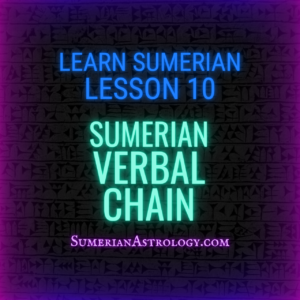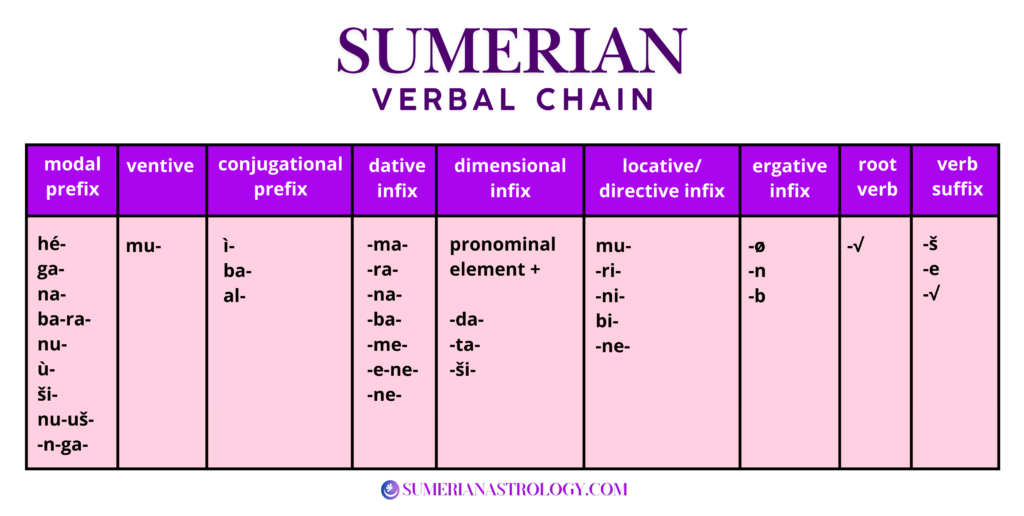Lesson 10
The Sumerian Verbal Chain
In this lesson, you’ll be introduced to the Sumerian verbal chain and its elements, which we’ll be discussing in greater detail later!
Need a Refresher on Sumerian Sentences?
Helpful Terms
Here is a list of helpful terms you’ll encounter in this lesson. You can see the full Glossary of Terms here.
- conjugational prefix (conj. pref.): a particle affixed at the head of the verbal chain, which may or may not confer additional meaning about the action.
- dimensional infix (dim. inf.): a particle within the verbal chain which refers back to the nouns marked by the ablative (from), comitative (with), and/or terminative (to(ward)) postpositions.
- dative (dat.): a grammatical case which indicates motion toward someone, as in ‘to/for [a person]’, marked by -ra 𒊏.
- ergative (erg.): a grammatical case which indicates the agent; the noun doing the action, as in ‘[performed] by’, marked by -e 𒂊.
- impersonal (impers.): a class of nouns considered inanimate in Sumerian, such as animals, objects, places, as well as humans of lower social stature, such as slaves and enemies.
- infix (inf.): a particle within the verbal chain that refers back to particular cases within the nominal chain.
- locative (loc.): a grammatical case which indicates where something is happening, as in ‘in’, or ‘at’, marked by -a 𒀀.
- modal-prefix (mod. pref.) a particle prefixed to the verbal chain indicating a modality such as mood, tense, aspect, voice, etc.
- personal (pers.): a class of nouns considered animate; namely deities and humans of high social status (excludes slaves, enemies, etc.).
- verbal chain: a string of prefixes, infixes, and suffixes attached to a verb to provide additional information about the action.
Vocabulary to Memorize
I highly recommend memorizing these Sumerian words, as you’ll encounter them often in the upcoming lessons!
- ì 𒉌 n., butter, oil, fat, cream; oil container. part., stand-alone agentive prefix ‘I’; conjugational prefix (indicates distance from speaker).
- íb 𒌈 n., hips; middle. v., to be angry; to curse. part., stand-alone agent prefix ‘he/she/it’ (impers.)
- in 𒅔 n., abuse, insult, offense. part., stand-alone agent prefix ‘he/she/it’ (pers.).
- na 𒈾 n., man; incense; rock, stone; token. part., dative infix ‘to/for him/her’.
- ni 𒉌 part., locative infix indicating ‘where’.
Vocabulary--Full List
Here are the vocabulary terms for this lesson. Be sure to look them over as they’re updated with additional meanings each lesson. You can see the full Sumerian Lexicon here.
- a 𒀀 n., water, semen, progeny, canal, flood. part., in, at, when; nominalizing suffix.
- dù 𒆕 v., to beget; bear (a child); be born; build, create, fashion, make; transform, change.
- e 𒂊 v., to speak, say; do; water. part., [performed] by (the agent); in, at, beside.
- é 𒂍n., house, temple.
- ì 𒉌 n., butter, oil, fat, cream; oil container. part., stand-alone agentive prefix ‘I’; conjugational prefix (indicates distance from speaker).
- íb 𒌈 n., hips; middle. v., to be angry; to curse. part., stand-alone agent prefix ‘he/she/it’ (impers.)
- in 𒅔 n., abuse, insult, offense. part., stand-alone agent prefix ‘he/she/it’ (pers.).
- iri 𒌷 n., city, town, village, district.
- lugal 𒈗 n., king; owner, master, lord.
- na 𒈾 n., man; incense; rock, stone; token. part., dative infix ‘to/for him/her’.
- ni 𒉌 part., locative infix indicating ‘where’.
- nin 𒎏 n., lady, mistress, owner, queen; lord (sometimes found in male names).
- ra 𒊏 v., to accompany; bear; drive; go; lead; multiply; mix, stir. part., to/for (pers.)
- uš 𒍑 n., foundation; distance; dimension; edge; man; penis. v., to support, lift; transport; join; be adjacent to. num., 60. part., personal suffix ‘they/them’ when the root verb ends in /u/.

Verbal Prefixes
To be considered grammatically correct, Sumerian verbs MUST be modified! For this reason, the Sumerian verbal chain will often start with a verbal prefix that may or may not confer additional meaning.
We’ll be diving into each of the verbal prefixes you might encounter in future lessons. For now, let’s get comfortable with the idea of modifying a verb. But before we can do that, we need to talk a little bit about Sumerian word gender.
Рersonal and IМpersonal
In some languages, nouns have a gender, such as masculine or feminine. Technically, the Sumerian language also gender, which relates to whether a noun is animate or inanimate. However, a better way to understand Sumerian gender is in terms of personal and impersonal.
Personal nouns include deities and most people of high regard. Impersonal nouns refer to inanimate objects, animals, and people considered to have a low social status, such as slaves and enemies. This is important, as Sumerian gender affects things like pronouns and infixes, as you’ll see!
Modifying a Verb
The verb dù 𒆕 means ‘to build’. Since it can’t stand-alone in a Sumerian sentence, we’ll need to attach a prefix; preferably one that will provide additional meaning to the reader.
In fact, if the verbal chain provides enough information, the nominal chain can be omitted altogether!
AgenТ Prefixes
Observe how the following prefixes express information about the agent; that is, the person performing the action.
- ì-dù 𒉌𒆕 I built it
- e-dù 𒂊𒆕 you built it
- in-dù 𒅔𒆕 he/she built it
- in-dù-uš 𒅔𒆕𒍑 they built it (personal)
- the 3rd person personal ending includes the plural suffix /š/, which appears as -uš 𒍑 when preceeded by a /u/.
- {dù + /š/ = dù-uš]
- the 3rd person personal ending includes the plural suffix /š/, which appears as -uš 𒍑 when preceeded by a /u/.
- íb-dù 𒌈𒆕 they built it (impersonal)
- the 3rd person impersonal DOES NOT include the plural suffix /š/.
Verb Chain Order
Like the nominal chain, elements within the Sumerian verbal chain appear in a particular order. We’ll be discussing each of these elements in greater detail in subsequent lessons.
NOTE: I like to use the term “prefix” in relation to an element that can only appear at the beginning of the verbal chain, and “infix” when it can appear anywhere. Be aware that some grammars and Sumerologists opt to use the term ‘prefix’ for each of these elements, regardless of where they appear in the verb chain.
- modal-prefix (mod.)
- conjugational-prefix (conj.)
- dative infix (dat.)
- dimensional infix(dim.)
- locative/directive infix (loc./dir.)
- ergative infix (erg.)
- root verb(√)

The Verbal Chain Refers Back to the NoМinal Chain
Each element of the Sumerian verbal chain refers back to information contained within the nominal chain. Consider the following sentence, which I have split up between the nominal and verbal chains:
- Sumerian: lugal-e nin-ra iri-a é | ì-na-ni-in-dù
- Cuneiform: 𒈗𒂊𒎏𒊏𒌷𒀀𒂍 | 𒉌𒈾𒉌𒅔𒆕
- English: The king built a house in the city for the queen.
- Literally: king-by queen-for city-in house | he built it there for her
- Verbal Chain Breakdown:
- ì(conj.) 𒉌 a conjugational prefix that may imply distance from the speaker.
- not to be confused by the 1st person agent prefix from the earlier example
- ì-dù 𒉌𒆕 I built it
- not to be confused by the 1st person agent prefix from the earlier example
- na(dat.) 𒈾 the dative infix—refers back to whom the action was done for
- nin-ra 𒎏𒊏 for the queen
- –na- 𒈾 refers back to -ra 𒊏
- nin-ra 𒎏𒊏 for the queen
- ni(loc.) 𒉌 the locative infix—refers back to the location
- iri-a 𒌷𒀀 in the city
- -ni- 𒉌 refers back to -a 𒀀
- iri-a 𒌷𒀀 in the city
- in(erg.) 𒅔 the ergative infix—refers back to the agent
- lugal-e 𒈗𒂊 by the king
- -in- 𒅔 refers back to -e 𒂊
- lugal-e 𒈗𒂊 by the king
- dù(√)𒆕 the root verb
- ì(conj.) 𒉌 a conjugational prefix that may imply distance from the speaker.
Saving Time and Space
The Sumerian verbal chain seems complex, but it can save lot of time and space when you’re a scribe writing on a clay tablet. And as long as we have some context in the surrounding lines or story, many cuneiform signs can be omitted altogether.
For example:
- instead of writing:
- lugal-e nin-ra iri-a é ì-na-ni-in-dù
- 𒈗𒂊𒎏𒊏𒌷𒀀𒂍𒉌𒈾𒉌𒅔𒆕
- The king built a house in the city for the queen.
- we can just write:
- ì-na-ni-in-dù
- 𒉌𒈾𒉌𒅔𒆕
- He built it there for her.
Your Sumerian Language Journey Continues!
My goodness–you have NO idea how far you’ve just come! You just conquered what I think is THE most difficult part of learning Sumerian! In the next lesson, you’ll learn about reading cuneiform, so be sure to subscribe to my substack to get all of my articles as soon as they post!

